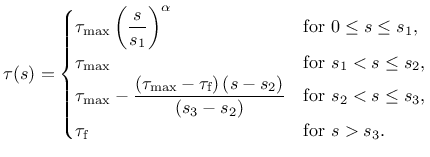Next: Material models for lattice Up: Material models for interfaces Previous: Simple interface material -
The complex steel/concrete interaction can be modelled with a bond-slip relation, which describes the bond stress (tangential interface traction), ![]() , in terms of the relative reinforcement slip (tangential interface jump),
, in terms of the relative reinforcement slip (tangential interface jump), ![]() . This interface material model is based on the local bond-slip relationship for reinforced concrete under good bond conditions outlined in the the fib Model Code for Concrete Structures 2010 [31].
In general, the model is formulated in terms of the interface traction vector
. This interface material model is based on the local bond-slip relationship for reinforced concrete under good bond conditions outlined in the the fib Model Code for Concrete Structures 2010 [31].
In general, the model is formulated in terms of the interface traction vector ![]() and the interface jump vector
and the interface jump vector ![]() .
In the model, the interface is assumed to have only elastic stiffness
.
In the model, the interface is assumed to have only elastic stiffness
![]() n in the normal direction. The normal interface traction is then evaluated elastically from the normal interface jump, i.e.
n in the normal direction. The normal interface traction is then evaluated elastically from the normal interface jump, i.e.
![]() n
n![]() n
n![]() n. The tangential traction
n. The tangential traction
![]() t
t![]() is evaluated from the user-specified function
is evaluated from the user-specified function ![]() , see Figure 12:
, see Figure 12:
 |
(231) |
For an exponent ![]() smaller than 1 (default value 0.4), the initial tangential stiffness of the interface,
smaller than 1 (default value 0.4), the initial tangential stiffness of the interface,
![]() s, is undefined and cannot be used in numerical computations. Therefore, this stiffness needs to be specified manually. Should the provided stiffness be smaller than
s, is undefined and cannot be used in numerical computations. Therefore, this stiffness needs to be specified manually. Should the provided stiffness be smaller than
![]() n
n![]() , it will be automatically adjusted to this value. Note that only elastic tangent stiffness is supported. Hence, in 2D the tangent stiffness matrix takes the form
, it will be automatically adjusted to this value. Note that only elastic tangent stiffness is supported. Hence, in 2D the tangent stiffness matrix takes the form
![$\displaystyle \dfrac{\partial \mbox{\boldmath$t$}}{\partial \mbox{\boldmath$\de...
...=
\left[ \begin{array}{cc}
k_\text{n} & 0 \\ 0 & k_\text{s}
\end{array} \right]$](img934.png) |
(232) |
Borek Patzak